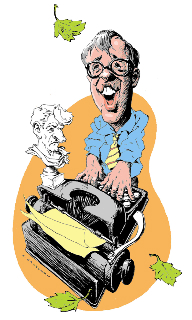Robert Beaser isn’t what you‘d call a sublime composer, but in that one tiny scene at least he seems to suggest that he knows what opera is all about. His opera is the final part of Central Park, a trilogy of short operas by American composers — Deborah Drattell and Michael Torke are the first two — produced last summer by the enterprising Glimmerglass Opera in upstate New York, later by the New York City Opera in Lincoln Center, and now, in performances videotaped at Glimmerglass, scheduled for KCET next Wednesday (January 19). McNally, Wendy Wasserstein and A.R. Gurney provided the librettos. Drattell Wasserstein’s The Festival of Regrets reunites a mother and her estranged daughter during a Rosh Hashana ritual at the park‘s Bethesda Fountain; the TorkeGurney Strawberry Fields has a fantasy-possessed old woman finding sympathetic resonance among younger fantasists at the John Lennon memorial. Professionalism is everywhere; the idea — three contrasting works sharing a common and famous Manhattan setting — is clever enough. The presence of two remarkable singers particularly adept at portraying unhinged women at any age — Lauren Flanigan and Joyce Castle — wraps the venture in cloth of gold.
All that’s missing — but, alas, it‘s an indispensable ingredient — is the music that draws the listener into the drama of human interaction that opera can be, from Figaro and Susanna exchanging smoochy-poo to Isolde pouring Tristan the fateful mickey. All three of these operas build toward some kind of climax involving a lot of people singing at the same time. Only in Beaser’s work, however, is there any sense of using attractively varied dramatic material — a small crowd standing in as a cross section of typical springtime Central Park visitors — as subject matter for a convincing musical portrait. At that, the rest of Beaser‘s music, here and in other works I’ve stumbled across — he is, would you believe, head of composition at Juilliard — comes up as a sequence of punch-card tune-formulas. The whole trilogy, in fact, running a painless two hours, seems designed to assure an audience that it may be modern but it won‘t bite. The assurance works; Central Park was the New York City Opera’s hottest ticket last fall. Since the alternative next Wednesday night is Faust at the Los Angeles Opera, you might as well tune in.
You can‘t deny, however, that new American opera is hot stuff these days. At the Metropolitan Opera there was John Harbison’s musicking of Fitzgerald‘s The Great Gatsby, higher in cleverness level than the paltry trio across the Lincoln Center Plaza, but afflicted with the same syndrome of the impersonal tune-formula that gets us from A to B with little sense of how we got there or why. There is a streak of splendor in Harbison’s works; his Mirabai Songs, as Dawn Upshaw sings them on Nonesuch, have the enchanting, intense lyrical flow that I waited in vain to hear on the Met‘s Gatsby broadcast. There is an undeniable ingenuity in Harbison’s blending of unalike idioms: the jazzy bits that sound from afar, even from a prop radio, during the party scenes; the kicky way Harbison has fragmented Mendelssohn‘s “Wedding March” into the Plaza Hotel episode. Upshaw’s Daisy came over as a wondrous synthesis of Violetta and Salome; Lorraine Hunt-Lieberson, in her long-overdue Met debut, found the resource — not in the pallid tunes but within the magic of her own voice — to transmute the Myrtle Wilson character into towering tragedy.
For now, at least, Gatsby has its fling; next season it goes to Chicago‘s Lyric, in a swap for William Bolcom’s A View From the Bridge, which I wish I‘d heard and will someday. But then what? I discern a rather large trash bin, with its accumulation of tinsel and sawdust growing ever higher. Will anyone ever bother again with Corigliano’s Ghosts of Versailles, without the expensive glitz of its Met premiere? What happens to Previn‘s Streetcar as the initial fame fades and there is no longer a Renee Fleming for a larger-than-life Blanche? Has hope vanished — as it should — for the ghastly Fantastic Mr. Fox that our own company got saddled with last millennium?
Meanwhile, there were Jane Eaglen and Ben Heppner for the Met’s unforgettable Tristan broadcast, followed not much later by PBS‘s Marriage of Figaro telecast made miraculous not only by Cecilia Bartoli’s playing the eye game but also by Dwayne Croft‘s wonderfully urgent Almaviva. Such bygone treasures gleam ever brighter in the dusk of these contemporary befuddlements.
A year ago I listed Esa-Pekka Salonen’s LA Variations as music to be revisited during the next century; last week‘s “Green Umbrella” concert proved me right — the music itself, and its continued power to drive an audience (in Mark Swed’s matchless choice of word) bananas. Local pride may play a part; still, I don‘t know another new piece in which a complex musical language, masterful in its choice of “resting” points (a tuneful moment as plateau) but basically challenging to ear and intellect, can simultaneously engage a hearer’s emotions.
The program — all Salonen, including the enchanting Five Images After Sappho, sung by Laura Claycomb as first heard at Ojai last summer — was an extraordinary affirmation of the treasure we possess in Salonen family, and the civic urgency in continuing their happiness here. The Philharmonic in Royce Hall, by the way, sounded like a million dollars. Why can‘t we just move that splendid building downtown and save a few Disney dollars in the process?


